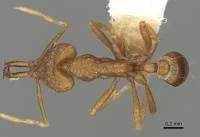Strumigenys hoplites
| Strumigenys hoplites | |
|---|---|

| |
| Scientific classification | |
| Kingdom: | Animalia |
| Phylum: | Arthropoda |
| Class: | Insecta |
| Order: | Hymenoptera |
| Family: | Formicidae |
| Subfamily: | Myrmicinae |
| Tribe: | Attini |
| Genus: | Strumigenys |
| Species: | S. hoplites |
| Binomial name | |
| Strumigenys hoplites Brown, 1973 | |
The only collection of this species was taken from a rotten log in a rainforest.
Identification
Bolton (2000) – A member of the mayri complex in the Strumigenys mayri-group. See Strumigenys akhtoi.
Keys including this Species
Distribution
Distribution based on Regional Taxon Lists
Indo-Australian Region: New Guinea (type locality).
Distribution based on AntMaps
Distribution based on AntWeb specimens
Check data from AntWeb
Countries Occupied
| Number of countries occupied by this species based on AntWiki Regional Taxon Lists. In general, fewer countries occupied indicates a narrower range, while more countries indicates a more widespread species. |

|
Estimated Abundance
| Relative abundance based on number of AntMaps records per species (this species within the purple bar). Fewer records (to the left) indicates a less abundant/encountered species while more records (to the right) indicates more abundant/encountered species. |

|
Biology
|
Castes
Nomenclature
The following information is derived from Barry Bolton's Online Catalogue of the Ants of the World.
- hoplites. Strumigenys hoplites Brown, 1973c: 266, fig. 2 (w.) NEW GUINEA. See also: Bolton, 2000: 885.
Unless otherwise noted the text for the remainder of this section is reported from the publication that includes the original description.
Description
Worker
TL 2.5-2.6, HL 0.70-0.76, HW 0.48-0.54, CI 67-71, ML 0.40-0.42, MI 55-57, SL 0.48-0.52, SI 96-100, PW 0.27-0.28, AL 0.67-0.72 (5 measured).
Characters of the mayri-complex. Preapical tooth spiniform, longer than maximum width of mandible. Dorsolateral margin of head with a single freely laterally projecting simple hair, the apicoscrobal. Cephalic dorsum with 4-6 erect simple hairs along the occipital margin and a similar pair at level of highest point of vertex. Preocular notch strongly present; ventral surface of head with a preocular transverse impression posterior to the deeply incised postbuccal groove. Pronotal humeral hair simple, pronotum otherwise without erect hairs; mesonotum with one pair of erect simple hairs. Dorsal alitrunk evenly reticulate-punctate. Dorsal surfaces of waist segments and first gastral tergite with simple hairs. Side of alitrunk reticulate-punctate except for katepisternum which has a small smooth patch. Propodeum armed with a pair of long slender needle-like spines that are elevated at about 45°; length of spine greater than dorsal width of petiole node, approaching width of disc of postpetiole. Dorsal (outer) surface of hind basitarsus without long fine erect hairs. Petiole in profile with anterior face of node equal to or slightly greater than length of dorsum, in dorsal view petiole node approximately as broad as long. Disc of postpetiole finely reticulate-punctate.
Type Material
Holotype worker and para type worker, PAPUA NEW GUINEA: Bisianumu, nr Sogeri, 15-20.iii.1955, 500 m., no. 655, rainforest (E. O. Wilson) (Museum of Comparative Zoology) [examined].
References
- Bolton, B. 2000. The ant tribe Dacetini. Memoirs of the American Entomological Institute. 65:1-1028. (page 885, redescription of worker)
- Brown, W. L., Jr. 1973c. The Indo-Australian species of the ant genus Strumigenys: groups of horvathi, mayri and wallacei. Pac. Insects 15: 259-269. (page 266, fig. 2 worker described)
References based on Global Ant Biodiversity Informatics
- Bolton, B. 2000. The Ant Tribe Dacetini. Memoirs of the American Entomological Institute 65
- Brown W. L., Jr. 1973. The Indo-Australian species of the ant genus Strumigenys: groups of horvathi, mayri and wallacei. Pac. Insects 15: 259-269.
- Brown W. L., Jr. 1973. The Indo-Australian species of the ant genus Strumigenys: groups of horvathi, mayri and wallacei. Pacific Insects 15: 259-269.
- Janda M., G. D. Alpert, M. L. Borowiec, E. P. Economo, P. Klimes, E. Sarnat, and S. O. Shattuck. 2011. Cheklist of ants described and recorded from New Guinea and associated islands. Available on http://www.newguineants.org/. Accessed on 24th Feb. 2011.

